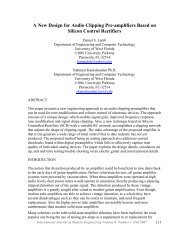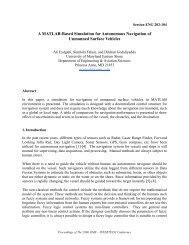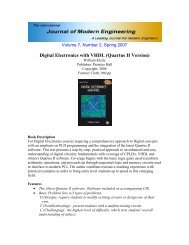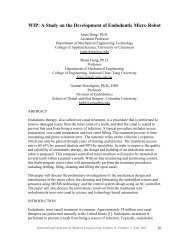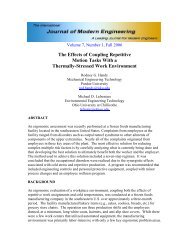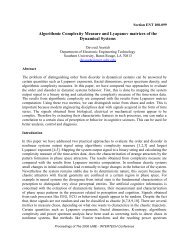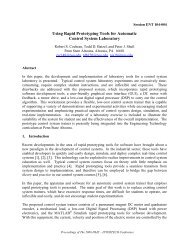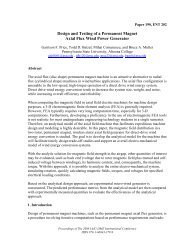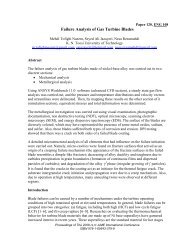Design and Analysis of Ultrasonic NDT Instrumentation ... - IJME
Design and Analysis of Ultrasonic NDT Instrumentation ... - IJME
Design and Analysis of Ultrasonic NDT Instrumentation ... - IJME
Create successful ePaper yourself
Turn your PDF publications into a flip-book with our unique Google optimized e-Paper software.
——————————————————————————————————————————————–————<br />
The LRUT application uses a 240V pk-pk electrical signal in<br />
the frequency range <strong>of</strong> 20kHz to 100kHz. The technique<br />
requires a number <strong>of</strong> excitations (<strong>and</strong> data collection) at a<br />
repetitive rate (rep-rate) <strong>of</strong> 0.1s for data manipulation. The<br />
main circuits involved are the transmit-circuit (TX), receive<br />
-circuit (RX), high-voltage power supply (CCPS) <strong>and</strong> the<br />
digital logic control circuits (DSP). The TX circuit produces<br />
a high-voltage, high-current electrical signal that excites the<br />
transducer array (load) that in turn produces the sound<br />
waves. The receive-circuit allows reception <strong>and</strong> signal processing<br />
<strong>of</strong> the echo signals from features. CCPS is a fast<br />
capacitor-charging power supply that produces +/-150V on<br />
dem<strong>and</strong>, which provides voltage to the TX. The DSP h<strong>and</strong>les<br />
system control, signal processing, storage <strong>and</strong> communication.<br />
Load characterization<br />
Load charecterisation is required for specifying the PRU’s<br />
port dynamics <strong>and</strong> power performance. Load for the PRU is<br />
an array <strong>of</strong> PZT transducers <strong>of</strong> the type EBL#2 [10] that are<br />
pre-engineererd with damping blocks <strong>and</strong> faceplates. A<br />
number <strong>of</strong> equivalent circuit models for PZT transducers are<br />
discussed in the literatue [5]. This work employed a singledimensional-thickness<br />
mode Krimholtz, Leedom <strong>and</strong><br />
Matthaei (KLM) model, as the KLM model allows<br />
additional layers such as face plates <strong>and</strong> matching layers to<br />
be easily added on to the model. Faceplates <strong>and</strong> matching<br />
layers can be modelled using the lossy transmission-line<br />
model. The derivation <strong>of</strong> parameters used in the KLM model<br />
for the PZT transducer requires three basic parameters<br />
that can only be obtained using practical measurements or<br />
by using equations [11]. They are free capacitance (C T ),<br />
resonant frequency (f p ) <strong>and</strong> anti-resonant frequency (f a ) <strong>of</strong><br />
the transducer. A Solartron SI1260 impedance analyzer was<br />
used for the practical impedance analysis. The measured<br />
free capacitance was approximately 1100pF at an excitation<br />
frequency <strong>of</strong> 1kHz. The resonant frequency (f p ) <strong>and</strong> antiresonant<br />
frequency (f a ) were measured as 1.7MHz <strong>and</strong><br />
2.4MHz, respectively. Another study claimed that for transducers<br />
having a thickness very much smaller than the other<br />
dimensions, the vibrations in directions other than thickness<br />
are insignificant for modeling purposes [12]. Hence, this<br />
single-dimensional model is adequate for the modeling process<br />
considered here.<br />
Practical input-impedance analysis results were compared<br />
with the simulation results across the frequency range <strong>of</strong><br />
interest. Figure 3 compares the simulation <strong>and</strong> practical<br />
results obtained for a single PZT. Impedance <strong>and</strong> phase<br />
graphs are set to show 20% <strong>and</strong> 2% error bars, respectively.<br />
A good agreement within 20% was obtained between the<br />
simulation <strong>and</strong> practical results.<br />
Impedance (Ω)<br />
1.00E+04<br />
9.00E+03<br />
8.00E+03<br />
7.00E+03<br />
6.00E+03<br />
5.00E+03<br />
4.00E+03<br />
3.00E+03<br />
2.00E+03<br />
1.00E+03<br />
0.00E+00<br />
1.00E+04<br />
2.00E+04<br />
3.00E+04<br />
Input impedance analysis<br />
(Single ELB#2 transducer)<br />
4.00E+04<br />
5.00E+04<br />
6.00E+04<br />
1.000E+05,<br />
1.699E+03<br />
1.065E+05,<br />
1.369E+03<br />
Figure 3. Input Impedance <strong>Analysis</strong> <strong>of</strong> a Single Domain PZT<br />
7.00E+04<br />
In LRUT applications, PZT elements are mounted to<br />
stainless steel backing blocks for damping <strong>and</strong> mounting<br />
purposes. This transducer fabrication also includes a faceplate<br />
for acoustic impedance matching <strong>and</strong> durability. The<br />
PZT transducer with backing block <strong>and</strong> faceplate is called<br />
an LRUT transducer. Each output port in the PRU system is<br />
specified to drive an array <strong>of</strong> LRUT transducers. The array<br />
size can be as big as 13 LRUT transducers connected in<br />
parallel.<br />
The total input impedance analysis for an array <strong>of</strong> 13<br />
LRUT transducers was also carried out practically <strong>and</strong><br />
through computer simulations. Faceplates were modeled<br />
using a transmission-line model. The stainless steel dampers<br />
were modeled with resisters, whose values were calculated<br />
using the acoustic impedance formula, R =ρAu p , where ρ, A<br />
<strong>and</strong> u p were the density <strong>of</strong> stainless steel, cross sectional<br />
area <strong>and</strong> phase velocity, respectively [13]. The practical <strong>and</strong><br />
simulated results are shown in Figure 4. Discrepancies within<br />
30% were observed between practical <strong>and</strong> simulation<br />
results. As the operating region <strong>of</strong> the LRUT application<br />
was well below the series resonance frequency <strong>of</strong> the PZTs,<br />
the load held capacitive properties as expected [11]. This<br />
can be seen in Figure 3, where the phase angles are around<br />
negative 90 degrees (-90°).<br />
A maximum <strong>of</strong> 40% variation in input capacitance was<br />
observed when practical tests were carried out on two batches<br />
<strong>of</strong> 77 transducers (within <strong>and</strong> between the batches).<br />
Hence, the 30% discrepancy observed in Figure 4 was acceptable.<br />
It was concluded from the modeling work that the<br />
minimum value <strong>of</strong> load impedance was 115Ω±30%<br />
(80.5Ω), which was confirmed through practical results.<br />
8.00E+04<br />
Excitation frequency (kHz)<br />
Impedance - Practical<br />
Phase - Practical<br />
9.00E+04<br />
1.00E+05<br />
1.10E+05<br />
-82<br />
-88<br />
-94<br />
-100<br />
Phase (°)<br />
Impedance - Simulation<br />
Phase - Simulation<br />
——————————————————————————————————————————————–————<br />
90 INTERNATIONAL JOURNAL OF MODERN ENGINEERING | VOLUME 12, NUMBER 1, FALL/WINTER 2011



